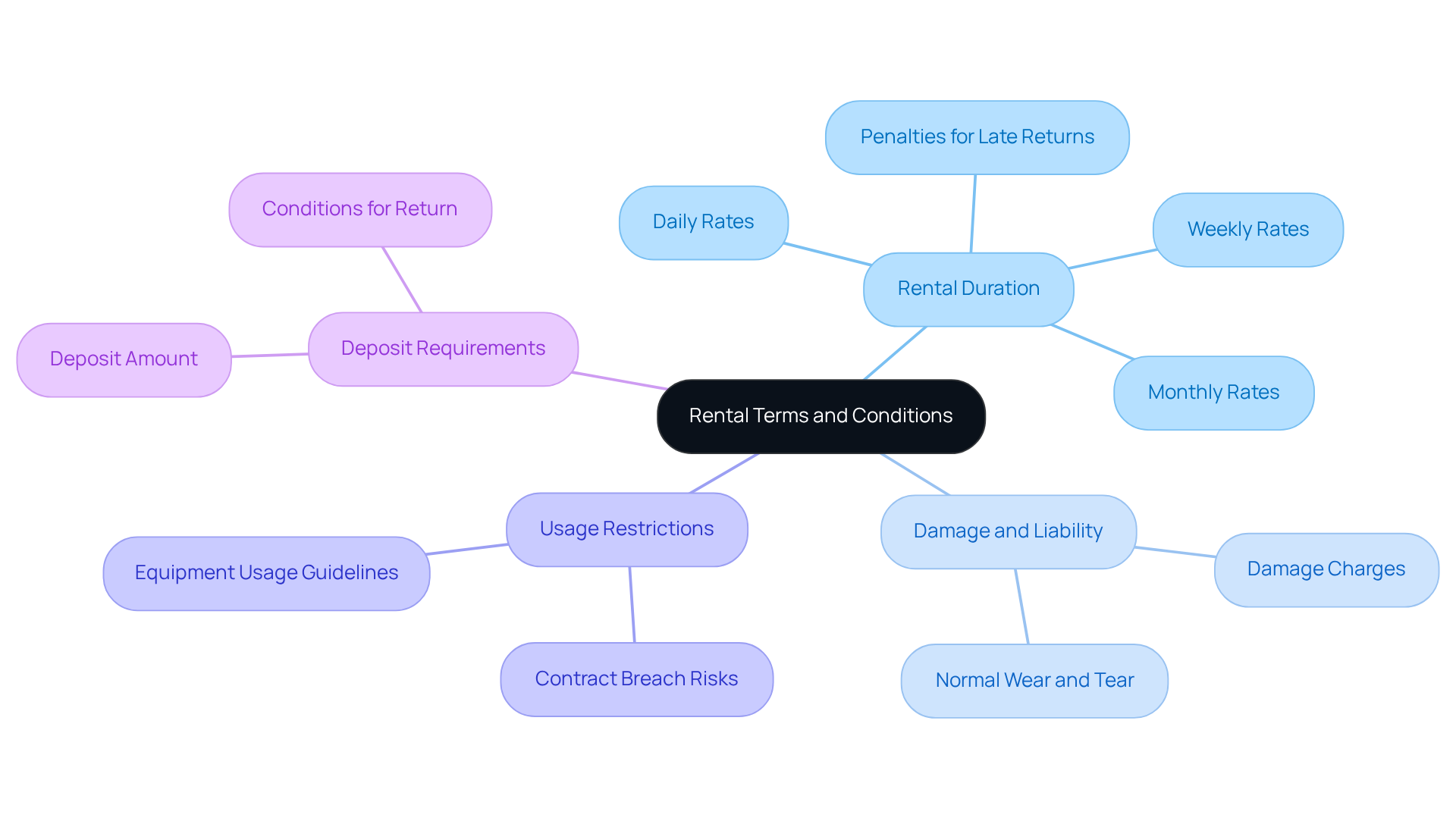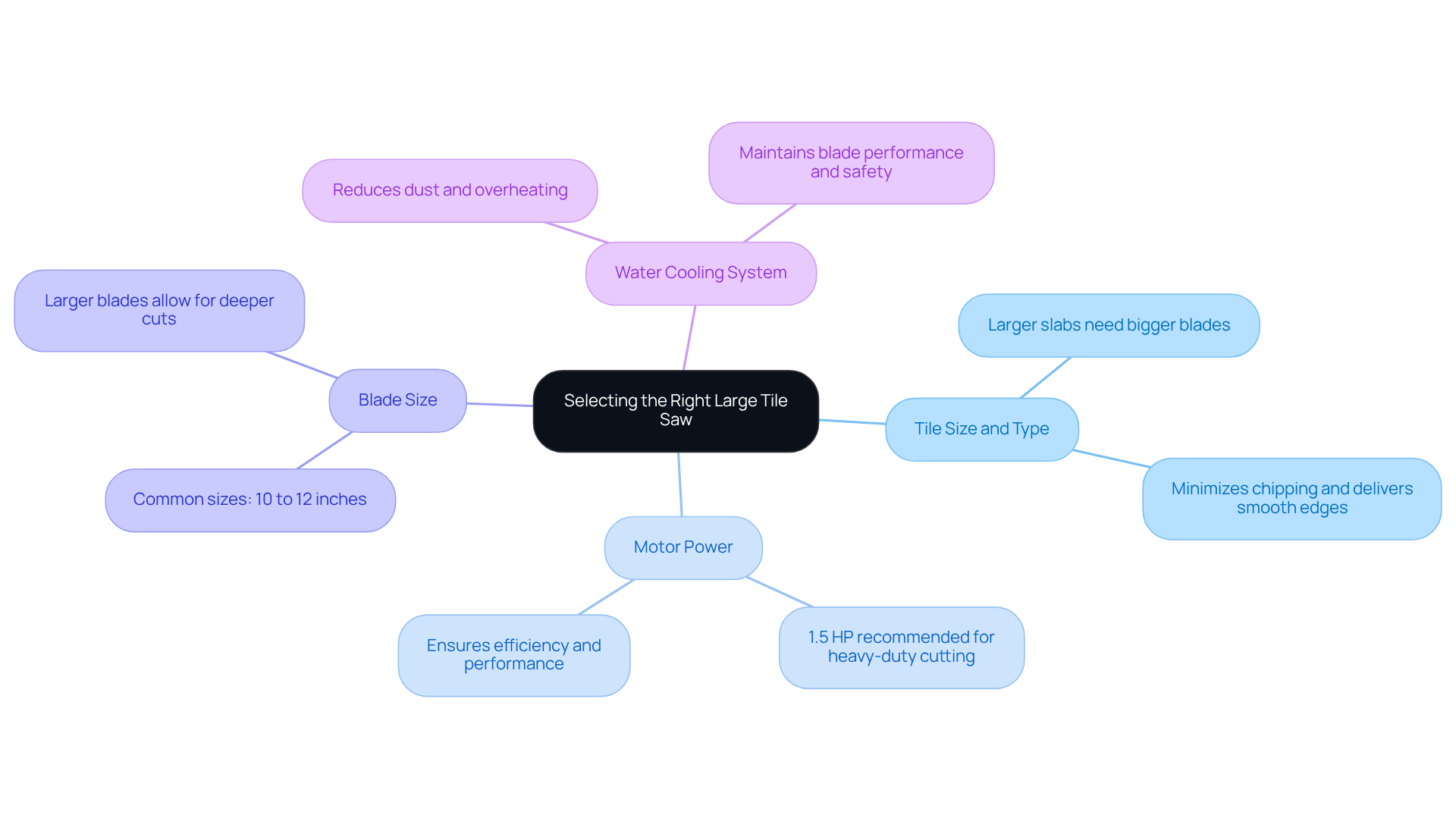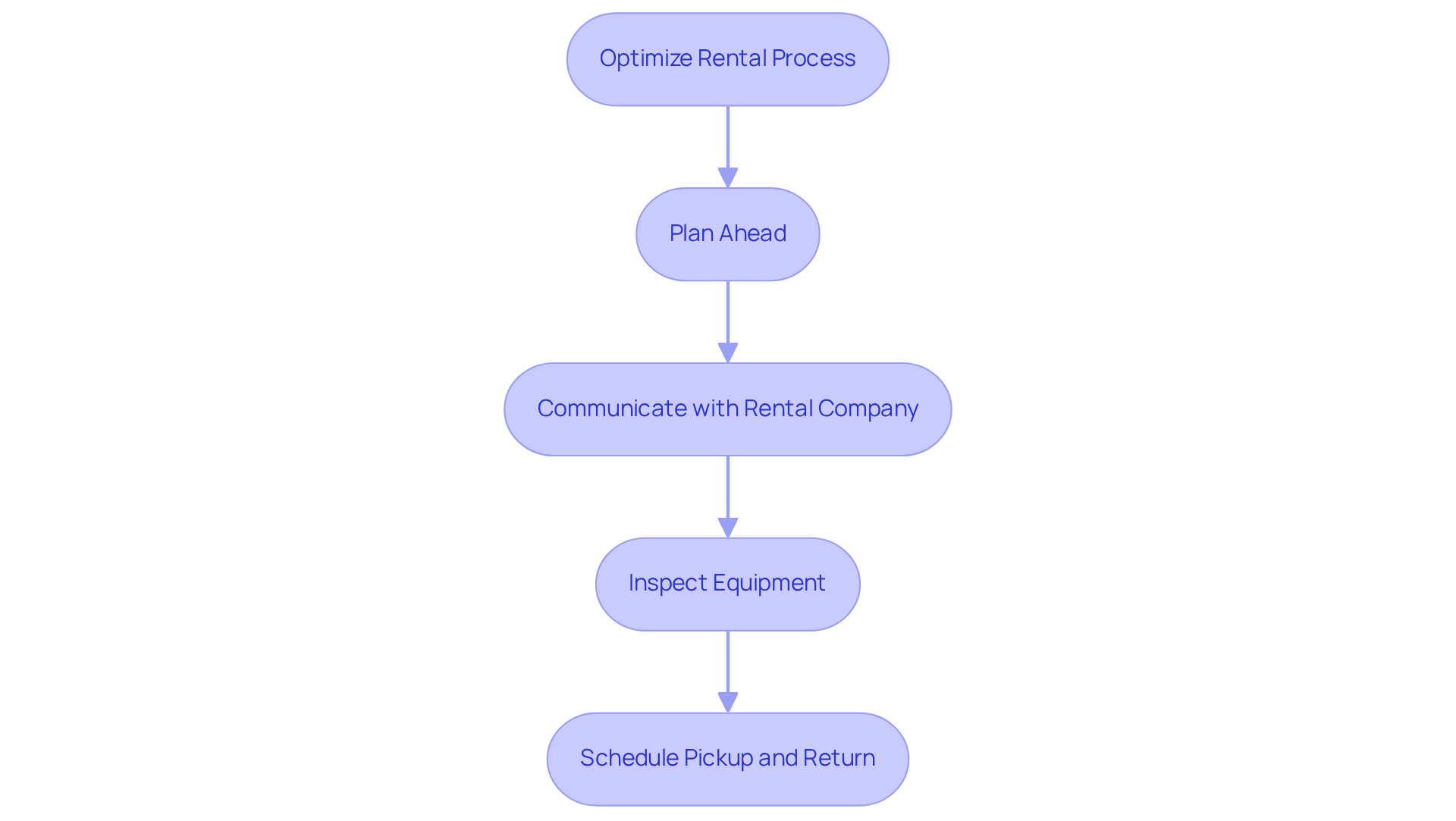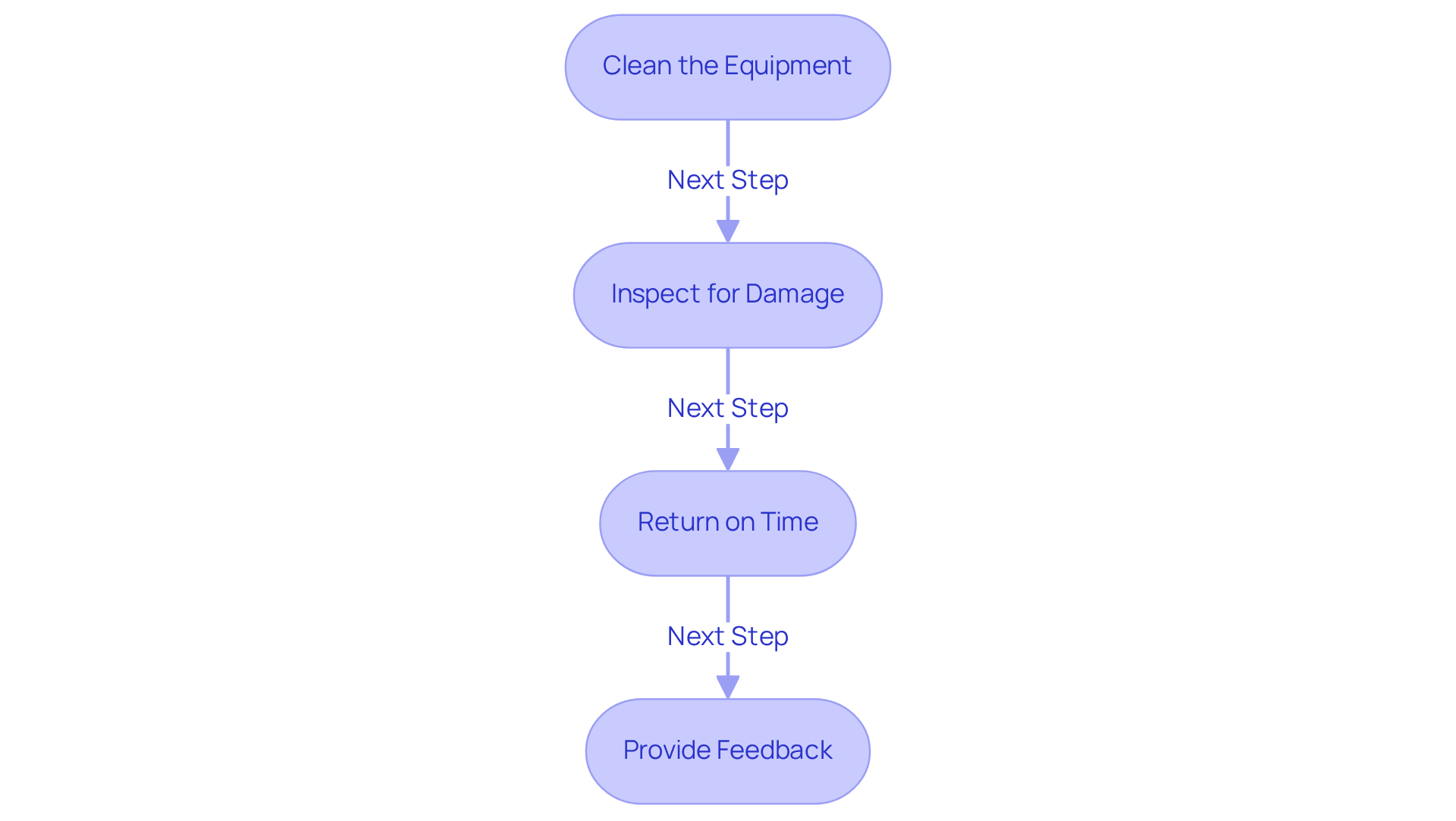Overview
Key practices for large tile saw rental success include:
- A thorough review of rental terms
- The selection of the appropriate saw
- Advance planning of rental needs
- The implementation of effective post-rental practices
Understanding rental conditions is crucial; it ensures that you are fully aware of your obligations and the equipment's capabilities. Choosing the right equipment based on project requirements enhances efficiency and effectiveness, making your rental experience seamless. Maintaining communication with the rental company is essential, as it fosters a collaborative relationship that can lead to better service and support. Finally, ensuring proper equipment care after use not only prolongs the life of the tools but also reflects your professionalism. These practices collectively contribute to a smooth and efficient rental experience.
Key Highlights:
- Review rental terms and conditions carefully, focusing on rental duration, damage policies, usage restrictions, and deposit requirements.
- Select the right large tile saw by considering tile size, motor power (at least 1.5 HP recommended), blade size (10 to 12 inches), and the presence of a water cooling system.
- Plan rental needs ahead of time to avoid last-minute scrambles, and communicate with the rental company for advice and potential discounts.
- Inspect the equipment before rental to ensure functionality and avoid issues during the project.
- Coordinate pickup and return times to align with project schedules, preventing late fees.
- After use, clean the equipment, inspect for damages, return on time, and provide feedback to the rental company to maintain a positive relationship.
Introduction
Navigating the realm of large tile saw rentals presents unique challenges, particularly given the escalating demand for high-performance cutting tools in the thriving construction sector. Grasping the nuances of rental agreements, choosing the appropriate equipment, and streamlining the rental process are essential steps that can profoundly influence the success of any project. But what occurs when the equipment falls short of expectations or unexpected hurdles emerge? This article explores four pivotal practices designed to facilitate a seamless and successful large tile saw rental experience, ensuring that projects progress efficiently from inception to completion.
Understand Rental Terms and Conditions
Before proceeding with a large tile saw rental, it is imperative to meticulously review the rental terms and conditions provided by the rental company. Key aspects to focus on include:
- Rental Duration: Understand the time frame for which you are renting the equipment. Be aware of daily, weekly, or monthly rates and any penalties for late returns.
- Damage and Liability: Familiarize yourself with the policies regarding harm to the devices. Know what constitutes normal wear and tear versus damage that could incur additional charges.
- Usage Restrictions: Some leasing agreements may specify how the equipment can be used. Ensure you are aware of any limitations to avoid breaching the contract.
- Deposit Requirements: Many leasing companies require a deposit. Understand how much this is and the conditions for its return.
By comprehensively understanding these terms, you can avoid misunderstandings and ensure a hassle-free rental experience.

Select the Right Large Tile Saw for Your Project
Selecting the appropriate large tile saw requires careful consideration of several key factors:
- Tile Size and Type: Begin by determining the size and type of tiles you will be cutting. Larger slabs necessitate a saw equipped with a bigger blade and a more powerful motor. Tile saws are specifically designed to minimize chipping and deliver smooth edges, which is crucial for achieving high-quality results.
- Motor Power: It is essential to choose a saw that boasts sufficient horsepower (HP) to handle the material you are cutting. A motor with at least 1.5 HP is recommended for heavy-duty cutting, ensuring both efficiency and performance.
- Blade Size: Common blade sizes range from 10 to 12 inches. Opting for a larger blade allows for deeper cuts, which is particularly important for thicker materials, ensuring accuracy while minimizing the need for multiple passes.
- Water Cooling System: A wet saw utilizes water to cool the blade and reduce dust. Ensure that the saw features a reliable water system to maintain blade performance and safety. Additionally, appropriate safety equipment, such as gloves and protective eyewear, is advised when operating tile saws to prevent injuries.
By thoroughly assessing these elements, you can select a large tile saw rental that improves your project's efficiency and quality. With the U.S. Ceramic Flooring Market projected to reach USD 6.24 billion by 2030, the demand for efficient cutting tools is on the rise. Industry professionals emphasize that investing in the right equipment is vital for achieving optimal results in construction projects. Furthermore, consistent maintenance of cutting tools is essential for ensuring their durability and efficiency.

Optimize the Rental Process for Efficiency
To optimize the rental process for a large tile saw, consider the following strategies:
- Plan Ahead: Determine your project timeline and rental needs well in advance. This proactive strategy enables you to obtain the tools you require without urgent scrambles, particularly in an expanding market where the U.S. tool leasing industry is anticipated to attain US$ 20.8 billion by 2033. Planning ahead not only saves time but also ensures that you can secure a large tile saw rental without hassle.
- Communicate with the Rental Company: Discuss your project requirements with the rental company. Their expertise can offer insights on the best tools for your needs and any available discounts. As Abhishek Kataria, a business consultant, observes, "With the assistance of leased tools, contracts can easily fulfill significant projects within the estimated timeline and without exceeding the budget." Open communication is essential for maximizing the benefits of your rental experience.
- Always inspect the large tile saw rental before taking it home. Check for any existing damage and ensure all components are functioning properly to avoid issues during your project. This step is vital, particularly considering the challenges encountered by the machinery leasing sector, such as supply chain disruptions. Ensuring the equipment is in optimal condition will prevent setbacks and enhance project efficiency.
- Schedule Pickup and Return: Coordinate your pickup and return times to align with your project schedule. This helps avoid late fees and ensures you have the equipment when you need it. Effective scheduling is a key component of a smooth rental experience.
Applying these strategies can result in a more efficient leasing experience, ultimately benefiting your project. For example, case studies show that effective planning and communication can significantly impact project timelines and budgets, reinforcing the importance of these practices.

Implement Effective Post-Rental Practices
After completing your project, it is crucial to adhere to these essential practices for returning your large tile saw:
- Clean the Equipment: Thoroughly clean the saw to eliminate any debris or residue. This not only preserves the equipment's condition but also demonstrates respect for the leasing company's property, fostering goodwill for future agreements. Notably, aging equipment is nearly three times more likely to cause unplanned downtime than operator mistakes, underscoring the importance of proper maintenance.
- Inspect for Damage: Conduct a meticulous examination of the saw for any damages incurred during your usage period. Common damages to look for include blade wear, missing parts, and any signs of rust or corrosion. Document any issues with photographs to facilitate discussions with the leasing company if necessary.
- Return on Time: Ensure that you return the equipment by the agreed-upon deadline to avoid incurring late fees. If you anticipate needing an extension, promptly contact the leasing company to explore your options.
- Provide Feedback: Share your leasing experience with the company. Constructive feedback is invaluable for enhancing their services and can significantly improve your future experiences.
By implementing these post-lease practices, you not only maintain a positive relationship with your provider but also contribute to a smoother process for your upcoming projects. Remember, unplanned downtime costs manufacturers up to $50 billion annually, making it essential to care for rental equipment properly.

Conclusion
Understanding the key practices for large tile saw rental is essential for ensuring project success and efficiency. By grasping the intricacies of rental agreements, selecting the appropriate equipment, optimizing the rental process, and implementing effective post-rental practices, individuals can navigate the complexities of tile saw rentals with confidence.
The article emphasizes several critical points:
- The importance of thoroughly reviewing rental terms to avoid misunderstandings.
- The necessity of selecting the right saw based on project requirements.
- The value of optimizing the rental process through planning and communication.
- The significance of maintaining equipment and adhering to post-rental practices.
Each of these elements contributes to a smoother rental experience and enhances overall project outcomes.
In conclusion, embracing these best practices not only leads to successful tile saw rentals but also fosters positive relationships with rental companies. This ensures that future projects can be executed seamlessly. By taking the time to understand and implement these strategies, individuals can effectively manage their rental experiences, ultimately driving better results in their construction endeavors.
Frequently Asked Questions
Why is it important to review rental terms and conditions before renting a tile saw?
Reviewing rental terms and conditions is crucial to understand the rental duration, damage and liability policies, usage restrictions, and deposit requirements, which helps avoid misunderstandings and ensures a hassle-free rental experience.
What should I know about rental duration when renting a tile saw?
You should understand the time frame for which you are renting the equipment, including daily, weekly, or monthly rates, as well as any penalties for late returns.
What are the damage and liability policies I need to be aware of?
Familiarize yourself with what constitutes normal wear and tear versus damage that could incur additional charges, as outlined by the rental company.
Are there any usage restrictions I should consider?
Yes, some leasing agreements may specify how the equipment can be used, so it’s important to be aware of any limitations to avoid breaching the contract.
What are the deposit requirements for renting a tile saw?
Many leasing companies require a deposit, so you should understand how much this is and the conditions for its return.




